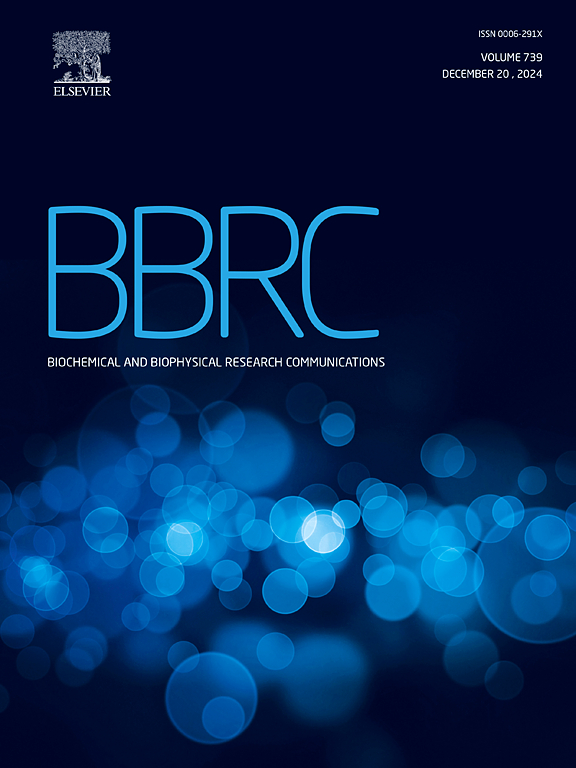Effect of early-life stress on LINE-1 in animal model of child neglect
IF 2.5
3区 生物学
Q3 BIOCHEMISTRY & MOLECULAR BIOLOGY
Biochemical and biophysical research communications
Pub Date : 2025-04-09
DOI:10.1016/j.bbrc.2025.151787
引用次数: 0
Abstract
The need for objective methods to assess child neglect has intensified. However, no biological indicators have been established for this purpose. Recently, early-life environments such as maternal attachment have been shown to affect the activity of long-interspersed nuclear element-1 (LINE-1, L1) in human infants and mouse pups. Herein, we hypothesized that the L1 copy number may correlate with the duration of neglect stress. To test this hypothesis, we employed a well-established mouse model of maternal separation that simulates early-life neglect. C57BL6/J mouse pups were subjected to daily maternal separation for either three or 6 h for two weeks from postnatal day (PND) one. We minimized the potential confounding effects of variations in maternal care by designating half of the littermates as untreated controls. L1 copy number in DNA extracted from the hippocampus and amygdala tissues at PND15 was quantified using real-time PCR with two different genes (5s-rRNA and Pthlh) as references. The results showed significantly higher L1 copy numbers in the hippocampus of pups separated for 6 h than in untreated controls. In addition, maternal separation duration was found to be correlated with L1 copy number in the hippocampus (r = 0.46, p < 0.001). Furthermore, the amplification of L1 in the hippocampus induced by 6 h of maternal separation was sustained until PND60. This study introduced a novel approach to understanding neglect-related L1 activity and highlighted the potential of L1 elements as an indicator in forensic medicine.
早期生活应激对儿童忽视动物模型中LINE-1的影响
对评估儿童忽视的客观方法的需要已经加强。然而,尚未为此目的制定生物指标。最近,在人类婴儿和小鼠幼崽中,早期生活环境(如母亲依恋)已被证明会影响长散布核元素-1 (LINE-1, L1)的活性。在此,我们假设L1拷贝数可能与忽视应激的持续时间有关。为了验证这一假设,我们采用了一种成熟的小鼠模型,模拟了早期生活中的忽视。C57BL6/J小鼠幼崽从出生第一天起,连续两周每天与母鼠分离3或6小时。我们通过指定一半的幼崽作为未经治疗的对照组,将母性护理变化的潜在混淆效应降到最低。PND15时,以两种不同基因(5s-rRNA和Pthlh)为参考,采用实时荧光定量PCR方法定量海马和杏仁核组织DNA中L1拷贝数。结果显示,与未处理的对照组相比,分离6 h的幼鼠海马L1拷贝数显著增加。此外,母体分离时间与海马L1拷贝数相关(r = 0.46, p <;0.001)。此外,母体分离6小时诱导的海马L1扩增持续到PND60。本研究介绍了一种新的方法来理解与忽视相关的L1活性,并强调了L1元素作为法医学指标的潜力。
本文章由计算机程序翻译,如有差异,请以英文原文为准。
求助全文
约1分钟内获得全文
求助全文
来源期刊
CiteScore
6.10
自引率
0.00%
发文量
1400
审稿时长
14 days
期刊介绍:
Biochemical and Biophysical Research Communications is the premier international journal devoted to the very rapid dissemination of timely and significant experimental results in diverse fields of biological research. The development of the "Breakthroughs and Views" section brings the minireview format to the journal, and issues often contain collections of special interest manuscripts. BBRC is published weekly (52 issues/year).Research Areas now include: Biochemistry; biophysics; cell biology; developmental biology; immunology
; molecular biology; neurobiology; plant biology and proteomics

 求助内容:
求助内容: 应助结果提醒方式:
应助结果提醒方式:


